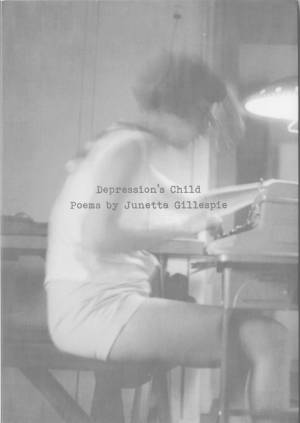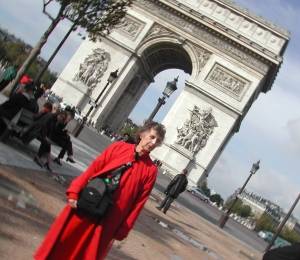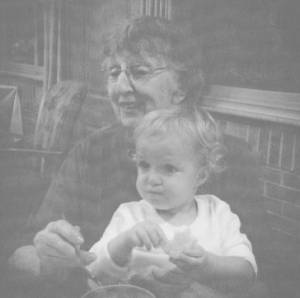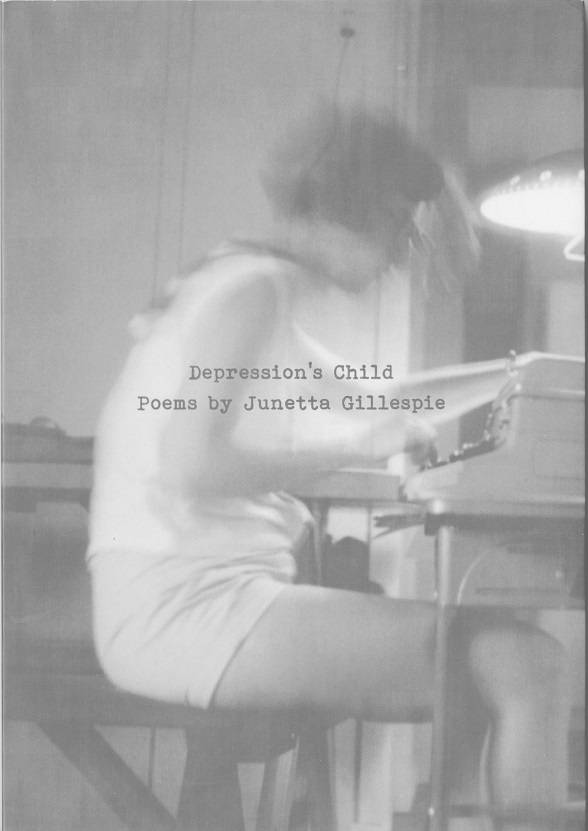Poetry, I feel, is subjected to more criticism than other literary works. Not every poet is Shakespeare, Eliot, Sandburg, or Angelou, but sometimes we, the readers, expect a poet to be phenomenal. Perhaps this expectation is from the amount of words on the page. Perhaps it’s because of the format with its stanzas (or lack thereof at times), pauses and breaks, and rhymes (or non-rhymes). With all of these expectations in mind, I approached Depression’s Child: Poems by Junetta Gillespie with none. In doing so, I found a collection of poetry that reflected its author, an introspective individual questioning and exploring the rhythms of life. I found myself wanting to know more about Junetta since her poems allude to a more complex individual. So, I reached out to her son, William Gillespie, for more information.
Published posthumously, Depression’s Child is a small collection of Junetta’s written work. The collection is broken into four parts: Part I focuses on childhood, Part II on raising children and maternal feelings, Part III on the seasons and the trials of mature adulthood, and Part IV on sickness and eventually death. The ordering of the poems in these parts seems purposeful when delving deeper into the collection.
 Throughout the collection, themes of astronomy, travel, nature, and wildlife emerge to punctuate the humanity in each poem. For example “Star Travel (1930s Style)” explores the narrator’s childhood fascination with space travel. The narrator imagines that “our ancient Chevy” travels from star to star with “every bump in the old highway.” It’s easy to imagine being the child in the back of a car traveling on dusty roads amid cornfields in the summer. You’re hot. You’re bored. Your mind wanders to somewhere different. The poem is very relatable for me. However, the thought of being up high, elsewhere and no longer terrestrial, is not a connection that I would’ve made as a child. The aspect of flying or traveling is a theme that emerges later in the poems “Flying West” and “Preparation for Landing” in parts III and IV respectively. These later poems focus on the trials of being supportive in a relationship and the preparation for one’s final descent to the Earth. While different, the concept sticks as poems about children leaving home (“For Meg, Leaving Home”) or friends departing (“After Saying Goodbye to an Old College Friend at Union Station, Chicago”) continue the thread of travel throughout the collection.
Throughout the collection, themes of astronomy, travel, nature, and wildlife emerge to punctuate the humanity in each poem. For example “Star Travel (1930s Style)” explores the narrator’s childhood fascination with space travel. The narrator imagines that “our ancient Chevy” travels from star to star with “every bump in the old highway.” It’s easy to imagine being the child in the back of a car traveling on dusty roads amid cornfields in the summer. You’re hot. You’re bored. Your mind wanders to somewhere different. The poem is very relatable for me. However, the thought of being up high, elsewhere and no longer terrestrial, is not a connection that I would’ve made as a child. The aspect of flying or traveling is a theme that emerges later in the poems “Flying West” and “Preparation for Landing” in parts III and IV respectively. These later poems focus on the trials of being supportive in a relationship and the preparation for one’s final descent to the Earth. While different, the concept sticks as poems about children leaving home (“For Meg, Leaving Home”) or friends departing (“After Saying Goodbye to an Old College Friend at Union Station, Chicago”) continue the thread of travel throughout the collection.
 Nearly all of Junetta’s poems are personal in some way. After reading a few, I found myself needing to know more about her in order to gauge my thoughts and feelings. A number of the poems are depressing in some small way whether it’s your child growing up (“Watching Popeye”), moving away from a well-loved home (“2198 Avy Avenue”), or realizing that your are older and you have left a previous self behind you (“Passport Photo”). Yet some poems are humorous. “Apocalypse in the Church School Basement” where the narrator imagines a flood as she acts out the discovery of Moses in the rushes by Pharaoh’s daughter is rather evocative. The flood “drowns” her audience thereby making them disappear. The narrator is left with her imagined scene and lines. Instead of getting what she wants (accolades and praise beyond measure), she’s given a picture of Daniel in the lion’s den. “In my next role I will be the lion / Who eats him.” The ending punctuates this childish sense of wanting more and receiving something less than what one’s creative imagination conjures up. Also, it hints at the narrator’s desire at becoming someone or something else, almost disappearing, while on stage.
Nearly all of Junetta’s poems are personal in some way. After reading a few, I found myself needing to know more about her in order to gauge my thoughts and feelings. A number of the poems are depressing in some small way whether it’s your child growing up (“Watching Popeye”), moving away from a well-loved home (“2198 Avy Avenue”), or realizing that your are older and you have left a previous self behind you (“Passport Photo”). Yet some poems are humorous. “Apocalypse in the Church School Basement” where the narrator imagines a flood as she acts out the discovery of Moses in the rushes by Pharaoh’s daughter is rather evocative. The flood “drowns” her audience thereby making them disappear. The narrator is left with her imagined scene and lines. Instead of getting what she wants (accolades and praise beyond measure), she’s given a picture of Daniel in the lion’s den. “In my next role I will be the lion / Who eats him.” The ending punctuates this childish sense of wanting more and receiving something less than what one’s creative imagination conjures up. Also, it hints at the narrator’s desire at becoming someone or something else, almost disappearing, while on stage.
All in all, Depression’s Child is an interesting reflection of its author, and I found myself wanting to know more about Junetta. In my own internet sleuthing, I was able to piece together (and later confirm) some facts about her. In reaching out to William Gillespie, her son and executor of her literary estates, I was able to piece together more of Junetta’s life story. Born in the Great Depression, she was raised in northeastern Iowa before spending her formative years in Iowa City. For college she left the Midwest for Swarthmore College in Pennsylvania to study English; however, as the book’s jacket notes, she transferred to Stanford University in order to pursue creative writing and go to beach parties. As her daughter Meg Gillespie elaborated for me, Junetta found Swarthmore insular and boring. When she transferred to Stanford, however, she found herself surrounded by “Los Angeles debutantes” seeking their MRS degrees and feeling utterly alienated.
 This detail from the Gillespies helped to support my own thoughts and impressions about Junetta based on her poetry. Essentially, she was a person who didn’t want to fit into the mold presented to her by society. She found her own way even if it meant conforming to some extent. Eventually, Junetta met and married Robert Gillespie, another Stanford student who studied economics. She traveled with him to MIT as he pursued his graduate studies. After he graduated, they settled as a married couple in Urbana as Robert began his career as a professor at the University of Illinois.
This detail from the Gillespies helped to support my own thoughts and impressions about Junetta based on her poetry. Essentially, she was a person who didn’t want to fit into the mold presented to her by society. She found her own way even if it meant conforming to some extent. Eventually, Junetta met and married Robert Gillespie, another Stanford student who studied economics. She traveled with him to MIT as he pursued his graduate studies. After he graduated, they settled as a married couple in Urbana as Robert began his career as a professor at the University of Illinois.
“The title of Depression’s Child alludes to both the fact that she was born directly into the Great Depression, when horizons were constrained and young women generally did not dream of becoming famous writers,” explained her son William. “She likely suffered from clinical depression before it became a socially recognized condition, and long before the advent of effective treatment through SSRIs such as Prozac. More importantly, she was a strong, independent woman whose generation was duty-bound to becomes wives and mothers, which is the path she took, but the consequences of which—curtailing her own musical and literary talents and vocational ambitions—she struggled with. She also despised being a ‘faculty wife’… [but] she found community in the Red Herring Poetry Collective, where she was able to practice her art among peers, and be repeatedly published in their journal Matrix.”
In reading Junetta’s poetry, one is struck by the melancholy of her thoughts and reflections. At first, I wanted to gloss over these feelings, but in learning more about Junetta, I find them pertinent. Life, at times or all the time, can be depressing for one reason or another. She was simply able to put some of those thoughts into words and express that feeling. She shared some of these poems during her lifetime, and in doing so, she made connections with others. In publishing more of her work, the Gillespies are creating more of these connections for those who appreciate the melancholy of life.
Depression’s Child: Poems by Junetta Gillespie can be purchased from I-Beam Books. An online archive of Junetta’s work is available at Spineless Books. Future publications of Junetta Gillespie’s work like her chapbooks Circus and Calligraphy will be forthcoming.
Sarah Keim is a contributing writer for Smile Politely’s Arts section. She’s a bit of recluse on social media, but you might bump into her out in the wilds of C-U. Except not this week or next week. She’s hittin’ the road in search of snow, mountains, and not having to hit the snooze button in the morning.
Color images provided by William Gillespie. Black & white images used with permission of Spy Beam Books.









 Sarah Keim is a contributing writer for Smile Politely’s Arts section. She’s a bit of recluse on social media, but you might bump into her out in the wilds of C-U. Except not this week or next week. She’s hittin’ the road in search of snow, mountains, and not having to hit the snooze button in the morning.
Sarah Keim is a contributing writer for Smile Politely’s Arts section. She’s a bit of recluse on social media, but you might bump into her out in the wilds of C-U. Except not this week or next week. She’s hittin’ the road in search of snow, mountains, and not having to hit the snooze button in the morning.